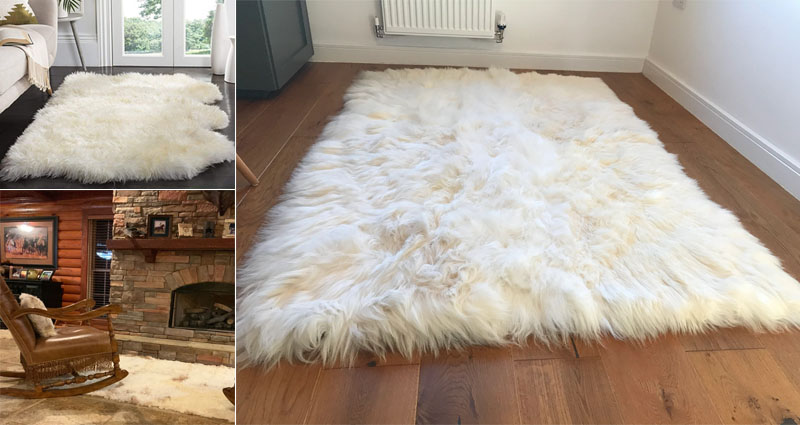Sheepskin rugs have a rich history that spans across centuries and holds cultural significance in many parts of the world. Beyond their practicality and aesthetic appeal, sheepskin rugs have played diverse roles in various cultures, symbolizing warmth, comfort, and even social status. In this blog post, we will delve into the fascinating history and explore the cultural significance of sheepskin rugs, shedding light on their evolution, symbolism, and traditional uses across different regions.
1. The Early Origins of Sheepskin Rugs:
Sheepskin rugs have a long and storied history that can be traced back to ancient civilizations. The use of sheepskins as floor coverings can be found in the nomadic cultures of Central Asia and the Middle East, where sheep provided essential resources such as meat, milk, and wool. The practice of utilizing sheepskins for practical purposes, including rugs and clothing, emerged from the necessity to make use of every part of the animal.
2. Symbolism and Traditional Uses:
Sheepskin rugs hold symbolic significance in many cultures around the world. In some societies, sheepskin rugs represent warmth, comfort, and protection. They are seen as a symbol of hospitality, often used to welcome guests or provide a cozy environment for gatherings. The softness and texture of sheepskin rugs create a sense of comfort and relaxation, making them a cherished addition to homes.
In other cultures, sheepskin rugs are associated with social status and wealth. Historically, they were reserved for the ruling elite or used in ceremonial settings to symbolize prosperity and luxury. The opulence and rarity of sheepskin rugs made them a valuable possession, demonstrating the wealth and influence of those who owned them.
3. Sheepskin Rugs in Scandinavian Culture:
In Scandinavian countries, sheepskin rugs have a deep-rooted cultural significance. Historically, they were utilized as functional items, providing warmth and insulation in the harsh Nordic climates. Sheepskin rugs were often used as bedding, lining for boots and clothing, and as floor coverings in traditional Scandinavian homes. These rugs offered natural warmth and comfort, enhancing the cozy atmosphere of the dwelling. Today, sheepskin rugs continue to be an integral part of Scandinavian decor, symbolizing comfort, coziness, and a connection to nature.
4. Sheepskin Rugs in Indigenous Cultures:
Sheepskin rugs also hold cultural significance in many indigenous cultures worldwide. In regions such as the Arctic and North America, sheepskin rugs were used by indigenous communities for practical purposes, including clothing, bedding, and insulation in dwellings. These rugs provided warmth and protection from the elements, especially in frigid climates. The production and decoration of sheepskin rugs were often influenced by unique cultural traditions, such as intricate beadwork or symbolic motifs that represented cultural identity and stories.
5. Sheepskin Rugs in Traditional Crafts and Art:
Throughout history, sheepskin rugs have been incorporated into traditional crafts and art forms. In regions like the Balkans and Central Asia, sheepskin rugs were intricately woven or embroidered with elaborate patterns and designs, reflecting the cultural heritage and artistic traditions of the communities. These rugs were highly valued as decorative items, often displayed as tapestries or wall hangings, and passed down through generations as treasured family heirlooms.
In some cultures, sheepskin rugs served ceremonial purposes, used as sacred objects or as offerings in religious ceremonies. They were believed to hold spiritual significance, connecting individuals to their ancestors and the natural world. The intricate craftsmanship and symbolism imbued in these rugs added depth and meaning to their cultural importance.
6. Modern-Day Appreciation and Adaptation:
In contemporary society, sheepskin rugs continue to hold a special place in home decor, fashion, and design. With their timeless appeal and natural beauty, sheepskin rugs are appreciated for their softness, texture, and ability to create a cozy and inviting atmosphere in modern interiors. Many designers and homeowners incorporate sheepskin rugs into contemporary spaces, paying homage to their cultural heritage while adapting them to fit contemporary aesthetics.
The appreciation for sheepskin rugs goes beyond their cultural significance. They are sought after for their natural warmth, hypoallergenic properties, and ability to add a touch of luxury and comfort to any room. Whether used as a soft and inviting floor covering, a cozy throw, or an accent piece, sheepskin rugs continue to captivate and inspire with their rich history and cultural ties.
Conclusion:
Sheepskin rugs have a fascinating history and hold cultural significance in many parts of the world. From their early origins in ancient civilizations to their continued appreciation in modern society, these rugs symbolize warmth, comfort, and cultural identity. The artistry, craftsmanship, and symbolism associated with sheepskin rugs have elevated them from mere functional items to treasured possessions and decorative accents. As we embrace the beauty and cultural significance of sheepskin rugs in our contemporary lives, we honor the legacy of these timeless and meaningful pieces.








